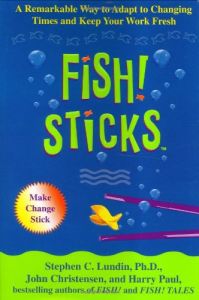Join getAbstract to access the summary!

Join getAbstract to access the summary!
Stephen C. Lundin, John Christensen and Harry Paul
Fish! Sticks
Make Changes Stick
Hyperion, 2003
What's inside?
The more things change, the more they stay the same — it just isn’t true. The hard job is getting real change to stick.
Recommendation
You’re back in the fishing boat with the crew that brought you the successful Fish! and Fish! Tales. Offering another finny fable, Stephen C. Lundin, John Christensen and Harry Paul present a business parable based on creating and sustaining successful change. The book uses the same fictitious approach as the other two Fish!ing trips, but this time the story is set at a hospital’s nursing station. The agent-of-change head nurse has departed and the new head nurse feels that the group is losing its vision. Then, she discovers that a local sushi restaurant is a model of excellence, and all goes swimmingly after that. Although the advice offered isn’t particularly unique, some may find a certain charm in the story. Given that this is round three, the format may seem a little repetitive to those who have already Fish!ed. If you want to catch the core of the message on your first cast, look for the highlights on the occasional pages in whale-size type. getAbstract.com recommends the basic common sense of these messages, even if the storytelling is a little fishy.
Summary
About the Authors
Stepehn C. Lundlin, the "Big Tuna, Ph.D.", is a writer, filmmaker and public speaker. He is the head counselor of the popular FISH! Camps. John Christensen is a filmmaker and CEO of ChartHouse Learning, a leading producer of corporate learning programs, including Fish!, the video. Harry Paul, a professional speaker, is a consulting partner with the Ken Blanchard Companies and the director of speaker services at Nelson Motivation, Inc., in San Diego.




















Comment on this summary